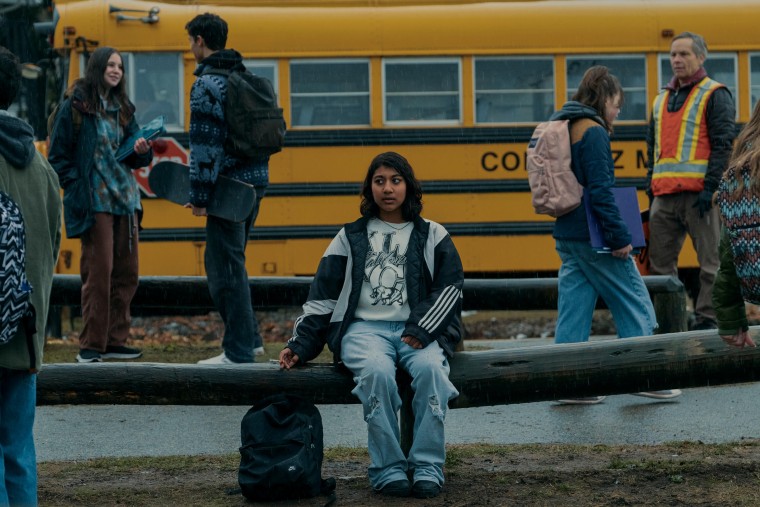How did a fight between a 14-year-old girl and a group of her teenage friends end in murder?
“Under the Bridge,” a new true-crime series on Hulu, is set to show viewers a dramatized version of the case of Reena Virk, a 14-year-old Canadian girl who was murdered near Victoria, Canada, in 1997.
The case led to murder convictions for two of the attackers: Kelly Ellard, who was 15 at the time of the slaying, and Warren Glowatski, then 16. Six other teens either pleaded guilty to or were found guilty of assault for their role in beating Virk under the Craigflower Bridge.
Vritika Gupta, who portrays Virk in the show, tells TODAY.com she felt a sense of pressure playing real people, but she hopes that the audience takes away the important parts of Virk’s story and have “purposeful conversations” about what is meaningful in life.
“The show did such a phenomenal job on really portraying how teenagers think,” Gupta said. “I’m a teen myself, and I think we all have our moments of not always fitting in. I think we’ve all walked into a room and felt different, and I think that portrayal was so important in the show, and was really well done.”
The series, starring Riley Keough and Lily Gladstone, is based on Rebecca Godfrey’s nonfiction book of the same name, which consists of six years of research, attending the trials and exclusive interviews with some of the teenagers accused of Virk’s assault and murder.
“I went home soon after (the killing) and went into the prison,” Godfrey told Interview Magazine in 2019 of returning to her hometown. “I was just stunned because the girls all looked like normal, cool, young teenage girls, not particularly like killers.”
The first two episodes of “Under the Bridge” premiere on Hulu on April 17, with new episodes airing weekly until the finale on May 29. Here’s what to know about the true story that inspired “Under the Bridge.”

What happened to Reena Virk?
Virk's schoolmates had bullied her due to her weight, appearance and religion, Godfrey wrote in her book. Virk's parents were devout Jehovah's Witnesses and her father Manjit was an Indian immigrant, while her mother Suman came from an Canadian-Indian family.
In a desperate attempt to gain more freedom, she falsely accused her father of sexual molestation and was briefly placed in foster care in 1996, according to Godfrey's book. The charges were dropped and Virk returned home, Godfrey reported.
On the night of Nov. 14, 1997, a group of about 50 to 60 teenagers were hanging out on the field behind Shoreline School, as they did on most Friday nights, according to Godfrey's book.
After police arrived and broke up the party, a group of teens moved under the Craigflower Bridge near Saanich, British Columbia, Canada, Godfrey reported. Virk was among the teenagers when an argument broke out, according to the Supreme Court of Canada, and she would never return home.
“As I was learning about Reena and her experiences, I really just wanted to put myself in her shoes and understand the things she did and why she did them,” Gupta says. “As we do things, in our head, we always have a sense that we’re ‘right.’ And we’re doing this because there’s a reason.”
Virk was "swarmed" by eight individuals where she was punched, kicked and burned with a cigarette, according to Supreme Court documents.

After the brutal assault, Virk made her way to the other side of the bridge, where two of the attackers, Ellard and Glowatski, followed her, according to court documents. The pair assaulted Virk again and ultimately drowned her in the Gorge Waterway under the bridge, according to court documents.
Virk's body was found more than a week later on Nov. 22, 1997, according to CBC. Coroner Dr. Laurel Gray conducted an autopsy on Nov. 24, 1997, and noted extensive damage to Virk's body, Godfrey wrote in her book.
"Multiple blows sustained in the abdominal area. A crush convulsion injury as often seen in car crash victims. Extensive bruising under the skin of her face. A bruise in the shape of a sneaker print is on the back of the brain," Godfrey wrote in an article published in Vice in July 2017. "In Reena’s lungs, she found eighteen pebbles. The presence of so many small stones led to her conclusion that the girl had been alive when she was in the water."
Gray concluded Virk had died by drowning, Godfrey reported.
What happened to Kelly Ellard and Warren Glowatski?
Ellard and Glowatski were charged with second-degree murder in connection with Virk’s death, according to the Supreme Court of Canada, and were both tried as adults in separate trials.
Glowatski was tried first, and he was convicted of murder in June 1999, according to the Supreme Court of Canada. He was sentenced to life in prison with no chance of parole for seven years, and was later granted parole in 2010.
Javon Walton, who portrayed Glowatski in the show, tells TODAY.com he was able to find older documents from when Glowatski was younger to help research his character.
“(Glowatski) was younger at the time, so it was hard for me to get a lot of documents to go off of, but I ended up finding a good amount. I kind of took that from there and I got to make the character my own ... it was definitely a tough role though,” Walton says. “It was very dynamic — I love the more layered roles, and it’s something that’s going to show a lot of acting abilities.”
Walton adds he found some redeeming aspects to Glowatski, including that he now speaks out and raises awareness on bullying.
“I feel like he has definitely redeemed himself a little bit from his past — there’s really no going back from what he did,” Walton said. “But at the same time, there’s definitely been a little bit of redemption.”
Walton was unable to speak to the Glowatski, who recently got out of jail. “There was part of me that kind of wanted to talk to him and see what was going through his head. But, at the same time, I was able to get a good sense of his character,” he said.
Ellard’s trial began in March 2000 and she was convicted later that month. CBC reported she was taken from the courtroom before she could say goodbye to her parents to begin serving her life sentence.
The British Columbia Court of Appeals ruled to overturn Ellard’s conviction in February 2003, according to the Supreme Court of Canada. Ellard’s second trial resulted in a mistrial in June 2004.
Jurors convicted Ellard again in April 2005, following her third trial. She received an automatic life sentence, and a judge set her parole eligibility at seven years.
In June 2017, Ellard was first granted day parole, according to CBC.
Day parole is a form of conditional release under Canadian law which allows offenders to participate in public activities during the day and requires that they return to prison or a halfway house nightly.
The parole board has been extending Ellard’s day parole in six-month increments, CBC reported. According to documentsobtained by CTV from the Parole Board of Canada filed when her day parole was extended in 2018, Ellard changed her name to Kerry Marie Sim.
Sim gave birth to her first child while in prison, and gave birth to her second child while on day parole in 2020, according to parole board documents obtained by CBC.
Who were the 'Shoreline Six?'
Six of the individuals, all girls between the ages of 14 and 16, who participated in the initial attack were prosecuted in Canada’s youth justice system in February 1998. While authorities did not identify the names of the girls as they were prosecuted as young offenders, the trial became known in the media as the “Shoreline Six.”
Chloe Guidry played Josephine Bell, a girl involved in the assault with a fictionalized name, in “Under the Bridge,” and tells TODAY.com finding out what happened to her character was “really important” for her as an actor.
“She did an absolutely horrible thing, honestly. But I think that the show tells a really good story of why these kids acted the way that they did,” Guidry says. “It was all coming from a sense of love and belonging that they wanted, and they never got. So they acted out in horrible ways. But for Jo, I feel like ultimately, she just wanted to get out. She knew what she was doing was bad, but she wanted to get out to escape it.”
Guidry says she thought the show accurately depicted what teenagers are going through, both in the 1990s and now.
“It really relates to a lot of teenagers out there that go through something and keep quiet,” she says. “What I want people to take away is how they treat each other. I feel like that’s so important with everything — your words have consequences, your actions have consequences, and really taking that away.”
Three of the six girls pleaded guilty to assault causing bodily harm, according to the Supreme Court of Canada. Jurors found three other girls guilty of the same crime at the conclusion of the trial, according to the Supreme Court of Canada.

